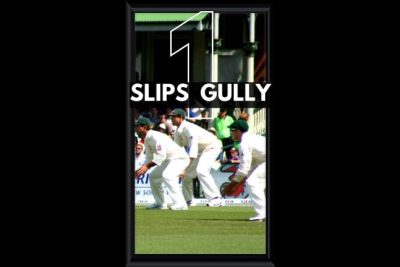Are you a cricket enthusiast curious about the strategic positions on the field that can make or break a game? Look no further! In the exhilarating sport of cricket, slip fielding positions hold immense importance. These key spots, located close to the batsman, require a unique set of skills and lightning-fast reflexes. Whether it’s the first slip, second slip, or gully, these positions demand unwavering concentration and agility, making them a thrilling spectacle for both players and spectators alike. Join us as we delve into the fascinating world of slip fielding positions in cricket and explore the crucial role they play in the outcome of a match.
What is the definition of slip position in the game of cricket?
Slip position in cricket refers to the placement of slip fielders behind the batsman on the off side of the field. These agile players make up the slip cordon or simply the slips. Their strategic positioning is crucial as they aim to catch any edged ball that goes beyond the wicket-keeper’s reach. With their keen reflexes and sharp anticipation, slip fielders play a vital role in securing wickets for their team.
In the game of cricket, the slip position is where the action unfolds. Positioned behind the batsman on the off side, the slip fielders form a formidable slip cordon. Their primary objective is to swiftly catch any edged ball that surpasses the wicket-keeper’s range. With their well-honed skills and unwavering focus, slip fielders are instrumental in creating those crucial breakthroughs that can turn the tide of a match. A slip fielder’s ability to react in an instant and snatch those flying edges is a sight to behold, making this position an essential element of the game.
What are the distinguishing characteristics of slip and gully?
Slip and gully, two fielding positions in cricket, share similarities but also have distinct differences. Both positions are located behind the wicket on the off side and are primarily used for attacking purposes. However, while slip is positioned slightly closer to the wicket, gully stands squarer and deeper. This variation in placement allows gully to be in the perfect position when a batsman opts for a cutting shot off the back foot.
The primary role of slip and gully is to excel in catching and saving runs. Positioned strategically, slip fielders are responsible for snatching catches that edge off the bat, adding pressure to the opposition. Gully, on the other hand, not only participates in catching but also serves as a defensive measure to prevent runs. With a squarer and deeper positioning, gully has a better chance of stopping the ball and restricting the batsman’s scoring opportunities.
While slip and gully may seem similar due to their attacking nature, the distinction lies in the angles and depth of their positions. Slip is slightly closer to the wicket, allowing for quick reactions to catches closer to the batsman. Gully, on the contrary, provides a wider angle and greater depth, making it the ideal position for defending against cutting shots played off the back foot. These contrasting placements contribute to the overall effectiveness of slip and gully in a cricket match.
What is the reason for calling it slips?
Slips, an intriguing term in cricket, derives its name from the primary purpose it serves on the field – to catch balls that slip from the bat at a fine angle. This vital fielding position, positioned behind the batsman, requires exceptional reflexes and coordination to swiftly snatch any errant shots. However, it is important to note that slips are just one part of the intricate fielding setup, as positions like “gully,” “third man,” and “point” also play crucial roles in ensuring a strong defense.
The Art of Precision: Mastering Slip Fielding in Cricket
Mastering slip fielding in cricket requires a combination of precision, agility, and impeccable reflexes. As the ball hurtles towards the slip cordon, fielders must be ready to pounce with lightning-fast reactions, ensuring that even the faintest of edges are not missed. The art of slip fielding lies in the ability to move swiftly and gracefully, maintaining a hawk-like focus on the bat and the trajectory of the ball. With their eyes locked on the action, slip fielders stand as the last line of defense, ready to make the game-changing catches that can turn the tide of a match.
To excel in slip fielding, one must possess immense concentration and a deep understanding of the game. Slip fielders must anticipate the movement of the ball, positioning themselves in the right place at the right time. The key is to maintain a balanced stance, keeping the body low and the hands in a poised position. Each movement must be measured and calculated, as the slightest misjudgment can result in a dropped catch. The art of precision in slip fielding is not only about catching the ball cleanly, but also about creating pressure on the batsmen, forcing them to make errors.
The art of precision in slip fielding extends beyond catching alone. Slip fielders must also possess the ability to communicate effectively with their teammates. They must have a thorough understanding of their role within the fielding unit and be able to react swiftly to any given situation. Whether it is a diving catch or a quick throw to the wicketkeeper, slip fielders must be in sync with their teammates, ensuring seamless coordination and maximum impact. It is this collaboration and precision that elevates slip fielding to an art form, where split-second decisions and flawless execution can make all the difference in the outcome of a cricket match.
Cricket’s Defensive Weapon: Unlocking the Secrets of Slip Fielding
Cricket’s Defensive Weapon: Unlocking the Secrets of Slip Fielding
In the game of cricket, slip fielding is often considered the most crucial defensive weapon. This specialized position requires exceptional reflexes, agility, and focus. The slip fielders stand close to the batsman, ready to catch any edges or deflections from the bat. With lightning-fast reactions, they can turn potential boundaries into wickets, making slip fielding an essential skill for any team aiming to dominate the game.
The key to successful slip fielding lies in anticipation and positioning. Slip fielders strategically position themselves in the slip cordon, a line of fielders extending from the wicketkeeper’s position. By studying the batsman’s technique and tendencies, slip fielders can predict the direction of the ball and adjust their stance accordingly. This anticipation, combined with their quick reflexes, allows slip fielders to make spectacular catches and dismissals, changing the course of the game in an instant.
Training for slip fielding involves a rigorous focus on hand-eye coordination and agility. Slip fielders undergo specialized drills that improve their reflexes and catching ability. These drills often include simulated batting sessions, where the slip fielder must react quickly to any edges or deflections. By honing their skills through repetitive practice, slip fielders develop the instinctive reflexes needed to snatch catches out of thin air, earning the admiration of fans and teammates alike.
In conclusion, slip fielding is a defensive weapon that holds immense importance in the game of cricket. With their lightning-fast reflexes, strategic positioning, and rigorous training, slip fielders have the ability to turn the tide of a match. Their exceptional skills and eye-catching catches make them an integral part of any successful cricket team, and unlocking the secrets of slip fielding can lead to a game-changing advantage on the field.
Positioning Mastery: Elevate Your Slip Fielding Skills in Cricket
Positioning Mastery: Elevate Your Slip Fielding Skills in Cricket
In the fast-paced game of cricket, slip fielding requires not only agility and quick reflexes, but also impeccable positioning. A skilled slip fielder is like a hawk, anticipating the trajectory of the ball and moving swiftly to the right spot. With precise positioning, they eliminate any chances of dropped catches and ensure their team’s success. By mastering the art of positioning, slip fielders can enhance their ability to intercept catches with ease, making them an invaluable asset on the field. So, whether it’s adjusting their stance or analyzing the batsman’s technique, investing time and effort into positioning mastery will undoubtedly elevate their slip fielding skills and set them apart from the rest.
Unleash Your Inner Fielding Maestro: Mastering Slip Positions in Cricket
Unleash your inner fielding maestro and become a master of slip positions in cricket. The art of slip fielding requires precision, agility, and lightning-fast reflexes. As the ball hurtles towards the batsman’s edge, you must position yourself strategically, ready to pounce on any opportunity. With unwavering focus and a keen eye, you can anticipate the trajectory of the ball and make breathtaking catches that leave spectators in awe. Whether you’re stationed at first slip, second slip, or beyond, mastering the art of slip fielding will elevate your cricketing prowess to new heights. So, step onto the field with confidence and let your inner fielding maestro shine as you dominate the slips and secure victory for your team.
In the dynamic game of cricket, slip fielding positions hold tremendous significance, serving as the last line of defense for a team. With their prime location behind the batsman, slips have the opportunity to snatch crucial catches and turn the tide of a match. Their impeccable reflexes, sharp anticipation, and unwavering focus make them the unsung heroes of the field. Whether it is the acrobatic dives or the lightning-fast reactions, slip fielders embody the essence of cricket’s thrilling spirit. Their presence adds an element of excitement and uncertainty, keeping fans on the edge of their seats until the very last ball.


